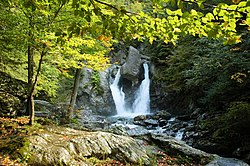Slovak Paradise National Park
| Slovak Paradise National Park Národný park Slovenský raj | |
|---|---|
 Stratenská píla tourist resort | |
| Location | East Slovakia, Slovak Paradise Mts. |
| Coordinates | 48°54′30″N 20°24′00″E / 48.90833°N 20.40000°E |
| Area | 197.63 km2 (76.3 mi2) |
| Established | 18 January 1988 |
| Governing body | Správa Národného parku Slovenský raj (Slovak Paradise National Park Administration) in Spišská Nová Ves |
Slovak Paradise National Park (
The National Park covers an area of 197.63 km2 (76.3 mi2), and the buffer zone around the park covers an area of 130.11 km2 (50.2 mi2); 327.74 km2 together. Eleven national nature reserves and eight nature reserves are situated in the park.
Park creation and history
The first protected reserve in the area of the Slovak Paradise was founded in 1890. The first protected plant was the
The name Slovenský raj first appeared in 1921 in the Krásy Slovenska magazine and replaced many names used until that period. On 21 August 1964 the first protected landscape area in Slovakia was established in the Slovak Paradise. The area was recategorized into a national park on 18 January 1988. In 2000 Dobšiná Ice Cave became a UNESCO World Heritage Site. Parts of the park also belong to the Natura 2000 network since 2004.
Geography

The National Park is situated in the Banská Bystrica Region (district of Brezno), Prešov Region (district of Poprad) and Košice Region (districts of Rožňava and Spišská Nová Ves).
The Slovak Paradise creates the northern part of the
Rivers and streams have formed many gorges, canyons, valleys, caves, and waterfalls in the Slovak Paradise, with the Hornád River being most important to the area. The core of the national park is a karst plateau cut into several smaller plateaux by deep rocky gorges. The most famous gorges are Veľký Sokol, which is also the longest at 4.5 km, Suchá Belá, Piecky, and Kyseľ, all of which have numerous waterfalls. Prielom Hornádu is the longest canyon at 11,7 km, and also contains the greatest diversity of species.[2] The highest waterfall is Závojový vodopád (literally Veil Waterfall) at 70 m.[3] The largest water reservoir is Palcmanská Maša, finished in 1956, which covers an area of 0.85 km2. It is used for swimming, water sports, fishing and other recreational activities.

The highest peak is Predná hoľa, at 1,545m
Geology
The geological formation of the Slovenský raj mountains is rather complicated. The majority of the territory is built by two basic units. The small, western one is the Bebrava unit separated from the eastern, larger Northern Gemer unit by the Muráň fault. Both of them are comparatively homogeneous, as the Mesozoic sedimentary rocks such as dolomite and sandstone prevail. As they were built by carbonate rock prone to karstification, the character of the Slovenský raj mountains is that of a karstic plateau. The relatively flat and rather short mountains of the Slovenský raj mountains were lifted up in the Tertiary and Quaternary periods. This caused the local river network to erode and create narrow and deep valleys.
Biology and ecology
The Slovak Paradise has the highest concentration of butterflies in Slovakia, with 6.06 butterflies per km2, of more than 2100 varied species. These fall into the greater 4000 species of
Forests cover 90% of the park. The most widespread trees are the beech, spruce, fir and pine. The park is home to 930 species of plants, of which 35 are protected. It contains six endemic plants, which are exclusively native to the immediate area, and 19 endemic plants native to the general West Carpathians.[7][8]
Tourism

The best known tourist centres and resorts are Čingov and Podlesok in the north,
The park offers about 300 km of hiking trails and several bike trails. One of the most visited routes is "Prielom Hornádu". In the northern part of the Slovak Paradise two main tourist centres of this region are situated: Čingov and Podlesok. They are connected by a 15 km long marked route, leading through the canyon along the Hornád river.
See also

References
- ^ "National Park of Slovenský raj". Slovak Tourist Board. n.d. Archived from the original on October 23, 2007. Retrieved May 25, 2007.
- ^ "Naj v Slovenskom raji (Records of the Slovak Paradise)" (in Slovak). mKs. n.d. Retrieved May 25, 2007.
- ^ "Waterfalls: Slovak Paradise". Slovak Tourist Board. n.d. Retrieved May 25, 2007.
- ^ Milan Chytry, Tomáš Dražil, Michal Hájek, Veronika Kalníková (September 2015). "The most species-rich plant communities of the Czech Republic and Slovakia (with new world records)". Retrieved 18 October 2022.
{{cite web}}: CS1 maint: multiple names: authors list (link) - ^ "Fauna" (in Slovak). mKs. n.d. Retrieved May 25, 2007.
- ^ "Rastlinstvo (Plants)" (in Slovak). Správa Národného parku Slovenský raj. n.d. Archived from the original on July 1, 2007. Retrieved May 25, 2007.
- ^ "Flóra" (in Slovak). mKs. n.d. Retrieved May 25, 2007.
- ^ "Živočístvo (Animals)" (in Slovak). Správa Národného parku Slovenský raj. n.d. Archived from the original on July 1, 2007. Retrieved May 25, 2007.
